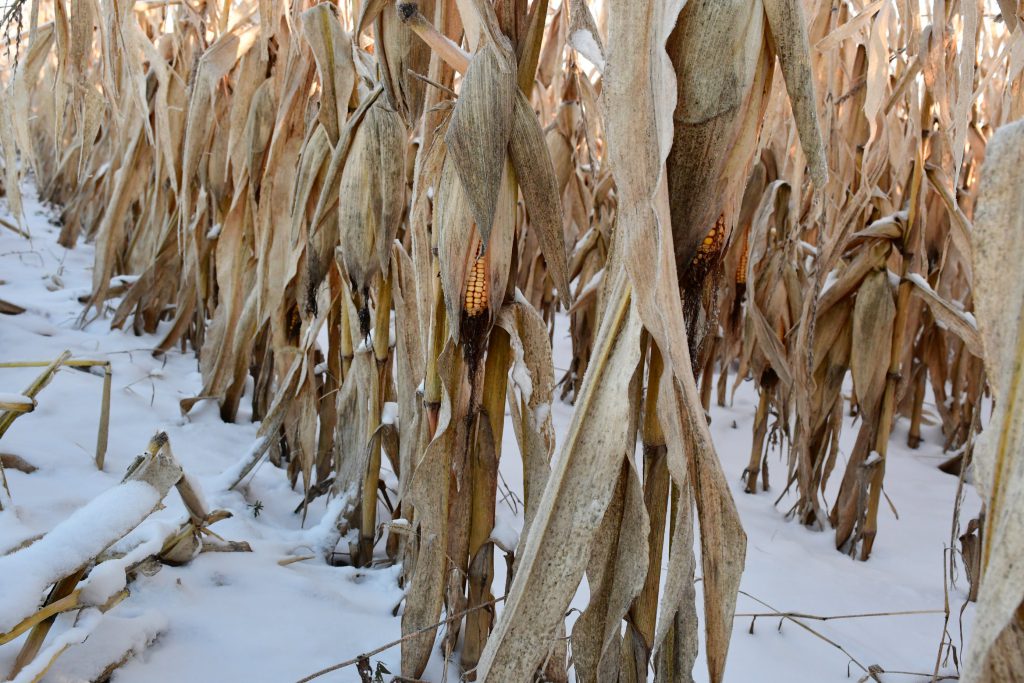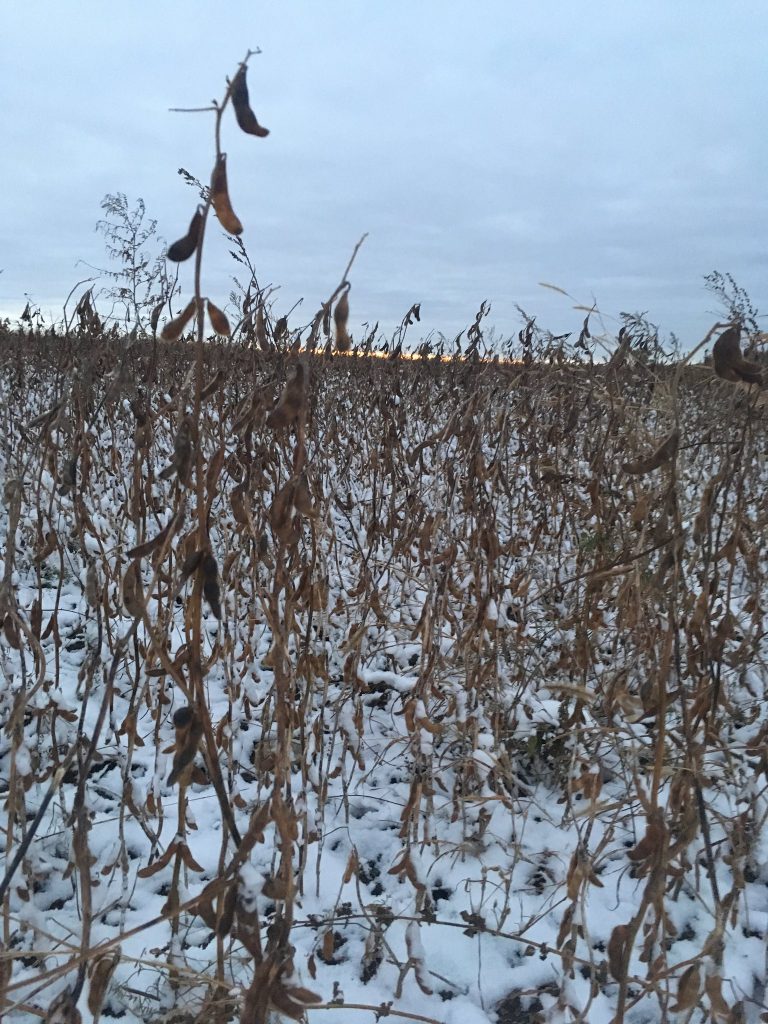What students wanted to know from #YourFarmers

Last week, we hosted for the first time ever, Live Q&A’s with Ontario grain farmers for teachers and students across Ontario. Ontario classrooms were able to virtually visit a grain farm and meet a grain farmer to learn more about Ontario grains and get their grain farming questions answered.
We had many interesting questions that were submitted by teachers ahead of time and that came up during our Live Q&A’s. Below are some of the common questions we got.
What equipment is used on a grain farm?
There is a lot of equipment that Ontario grain farmers use to grow, care for and harvest Ontario grains. And, the equipment they chose to use also depends on the type of operation they have. During spring planting there are tractors, planters and air seeders out in the fields putting the seeds into the ground. A tractor will pull a planter or air seeder, which are machines that are designed to efficiently and precisely plant barley, corn, oats, soybeans and wheat into the ready soil. Air seeders are especially innovative because they use high pressured air hoses to push the seeds into the ground, rather than digging a trench or hole to plant the seeds. Planters generally dig a hole or trench and place the seeds in, before covering the hole again. Air seeders are commonly found on farms that are using no-tillage practices. Regardless of what planting type machine farmers are using, all planters have one goal in common: plant the seeds into the ground at a pre-determined, consistent rate and make sure the seed is placed in a comfortable place in the soil to begin growing.
Farmers will also use different tillage practises to prepare the soil, and as a result, may need different tillage machines. These pieces of equipment will till or work the soil, so it is ready for planting.
In order to care for their crops, many farmers will also use sprayers to apply liquid fertilizers or pesticides. These machines carry the liquid mixture and spray the liquid close to the ground as it drives across the field. Sprayers will mix a chemical and water mixture in large holding tanks, then using high pressured hoses and preset rates, meter out the spray mixture onto the field. Farmers can determine how much pesticides or fertilizers they want to use on the fields by adjusting how much water is in the spray mixture, and how the spray comes of the sprayer. They can even adjust how large the liquid droplet’s sizes are to again, control exactly how much spray is going onto the fields.
During harvest, #YourFarmers will use a combine to harvest Ontario grains. This versatile machine is a great innovation that combines three tasks: reaping, threshing and winnowing. In simple terms, this machine can cut the mature grains in the field, separate the seeds from the rest of the plant, and collect the seeds and push out the leftover plant debris out the back. One combine can harvest all five Ontario grains- with different attachments on the front. The front part of the combine that cuts the plants down is called a header. Farmers will purchase different headers to attach to their combine, in order to harvest their different crops. A tractor and grain buggy or grain wagons are also an essential part of the harvest. These pieces of equipment collect the stored grain from the combine and drive it to either a grain elevator, a storage bin or to a waiting transport truck where it will be moved into the processing part of the food chain. A tractor will be attached to a grain buggy that will have a large storage tank and unloading auger to quickly unload grain into a truck. This auger goes above the side of the truck, to fill it from the top. Grain wagons are very similar to grain buggy’s but don’t have unloading augers. They have a sliding door on the bottom of the holding tank to let grain slide out and pour out.

What can grains be used for?
Ontario grains can be used in many different products we see and use every day! Ontario grains can be used in things like yarn, shampoo and conditioner, window cleaning products, rubbing alcohol and hand sanitizer, pet food, hand lotions, vinegar, paper, stamps, biodiesel, car seat cushions, plastic car panels. Grains can also be found in things like mayonnaise, Jell-O, band-aids, bread, crackers, oatmeal, granola bars, taco shells, soy sauce, candles, mouthwash, gravy and many kinds of cereals! Ontario grains are so versatile they can be used in many food items, many household items, and many other items we use every day. They can also be used to feed farm animals and make ethanol which is added to gasoline! Grain corn specifically is found in over 2,500 items in a grocery store alone!
How do plants grow? And how long do they grow for?
Ontario grain plants grow very similar to many other plants in the world like grass or trees. They need sunlight, water, plant food or nutrients and soil to grow in. Farmers plant their grains in the spring or fall (link to winter wheat post) where they grow until they are ready for harvest in the late summer or fall months. This is roughly 5-6 months they spend growing. Grains plants will start off as seeds, and sprout into baby plants that will develop roots underground to collect nutrients from the soil and will develop a stem and/or leaves above ground. The green part of the plant will grow above ground growing tall and developing leaves to then grow seeds on the plant fields. When we harvest grains, we cut down the plans specifically to collect those seeds. The seeds are then used to make food or other items. For example, oatmeal if just collected oat seeds from a full-grown oat plant that is cleaned and rolled out to be used in baking or as breakfast.
#YourFarmers job is to ensure the plants are put into the ground properly have that they are growing healthy- without harming the soil they are in or the local waterways. Farmers will make sure they have lots of plant food (nutrients) by applying fertilizers and aren’t sick or hurt by a pest. It’s the farmer’s job to keep their plants healthy and growing to make sure they can grow seeds that we can use to make food.
How much grain is harvested to make 2 cups of flour?
Wheat is harvested to make flour that can make pizza dough, cookies or bread. It takes roughly 1 cup of wheat seeds to make 2 cups of flour. Fun Fact: In nine seconds, a combine will harvest enough wheat seeds to make over 70 loaves of bread!
Where do you put grains once its snowing? What happens if the plants are still in the field and there is a snow storm?
There have been a few years where it is hard to finish harvest before winter weather hits! Grains that are already harvested, the harvested seeds are stored in waterproof grain bins where they will be kept dry until they are sold and shipping away. Corn for example can sit in grain bins all winter until ethanol decides to purchase more corn, and a truck hauls it away. Or, if the grains were sold as soon as they came off the fields, are away on ships to other countries to be made into food.
But, if the planted are still in the field and there is snowstorm, the grains must wait until they can be harvested. Most times, barley, oats and wheat are long since harvested before winter starts. Soybeans and corn however can be harvested after a snowstorm if the plants are cold or frozen, but they can’t be harvested when the fields are wet and muddy or there is a lot of snow sitting on the plants.


Sometimes, soybeans or corn wait until the spring when the snow melts to harvest. This is rare and can only happen if the plants stay standing over winter and don’t fall over with the weight of heavy snow.
How often do farmers rotate their crops to avoid stripping the soil of nutrients and causing soil erosion?
Farmers will try to rotate their crops every single year on every field on the farm. This will help “strip” the soil of naturally occurring nutrients and will help to naturally put nutrients back into the soil. For example, corn plants need a lot of nitrogen, a nutrient that will help them grow tall and produce corn cobs. But soybeans naturally produce nitrogen inside the plant. A common crop rotation to help reducing stripping of the soil could be planting soybeans on year 1. Then leaving the leftover plant parts of the soybean plant after the seeds are collected to naturally decompose and break down over the winter thus leaving the nitrogen from inside the plant, in the soil. Then on year 2, a farmer will plant corn into that field of soybean parts so the nitrogen will be ready for the corn to use as it is growing.
Soil erosion also happens when a field or soil becomes unhealthy or unfertile, so the soil is more likely to move around and leave the field through water or the wind. By rotating the crops, and the different nutrients that are used or added, soil can stay healthy and can help reduce soil erosion.
